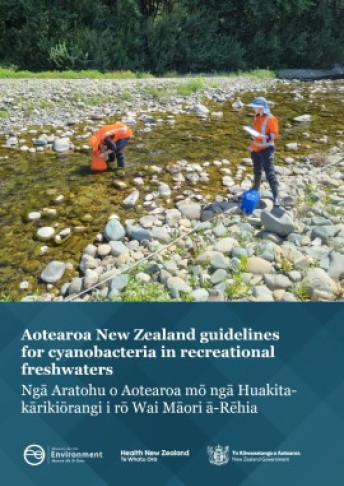These guidelines provide advice on how to manage public health risk associated with cyanobacteria in recreational freshwaters in Aotearoa New Zealand.
These guidelines provide advice on how to manage public health risk associated with cyanobacteria in recreational freshwaters in Aotearoa New Zealand.
They have been developed in response to requests from regional resource management and health agencies for best-practice advice, and are meant to:
- help these agencies develop monitoring protocols suitable for local conditions and circumstances
- encourage a nationally unified approach to managing cyanobacterial risk in waterways used for recreational purposes.
Correction note: These guidelines were updated on 1 April 2025 to correct a unit error in table A7.1: Biovolumes of common cyanobacteria in Aotearoa New Zealand. All units in the column headers were previously indicated as "mm", but the correct units are "μm".
What do these guidelines cover?
These guidelines set out a monitoring framework for establishing the public health risk from cyanobacteria associated with recreational activities in lakes (mainly planktonic cyanobacteria) and rivers (mainly benthic cyanobacteria).
They do not cover the public health risk associated with recreation in coastal or estuarine waters, food gathering (for example, shellfish), or drinking water. The maximum acceptable values for four classes of cyanotoxins (anatoxins, cylindrospermopsins, microcystins, nodularins and saxitoxins) in drinking-water supplies in Aotearoa can be found in the Water Services (Drinking-Water Standards for New Zealand) Regulations 2022. The accompanying ‘cyanobacterial compliance’ chapter of the Guidelines for Drinking-Water Quality Management for New Zealand informs drinking-water suppliers on how to monitor and manage drinking-water supplies for cyanobacteria and their toxins, including sampling requirements, recommended actions in response to threshold breaches, and treatment options.
For further advice on cyanotoxins in aquatic organisms (shellfish and others), contact New Zealand Food Safety at the Ministry for Primary Industries. Appendix 1 provides high-level information.
Finally, this document does not provide explicit guidance for managing the impacts of cyanobacterial events on other environmental values; there are more appropriate guidelines available for this, such as the New Zealand Periphyton Guideline.
Who should use these guidelines?
The Aotearoa New Zealand Guidelines for Cyanobacteria in Recreational Freshwaters are for staff and agencies involved in the monitoring of and reporting on recreational water.
Specifically, these are:
- science and policy professionals within regional councils and unitary authorities who routinely monitor the state of the environment
- public health professionals and practitioners in the National Public Health Service of Health New Zealand (HNZ) | Te Whatu Ora who assess and communicate environmental health risks to the public
- operational staff within territorial authorities who are responsible for alerting people to dangers in public spaces.
Section 2.4 contains more about the roles and responsibilities of these staff and agencies.
These guidelines may also interest the wider environmental science and environmental management community. For example, within councils, policy and planning staff who are developing freshwater policy may find useful some of the background material on the environmental causes of blooms. These guidelines cannot, however, be used for resource consenting work. For example, guideline thresholds cannot be used as the basis for establishing conditions for discharge consents, although they could be a component of the decision-making process.
The guidelines are a companion to the existing Microbiological Water Quality Guidelines for Marine and Freshwater Recreational Areas.
Related documents
The previous interim guidelines document published in 2009 can be accessed here: New Zealand guidelines for cyanobacteria in recreational fresh waters: Interim guidelines | Ministry for the Environment
